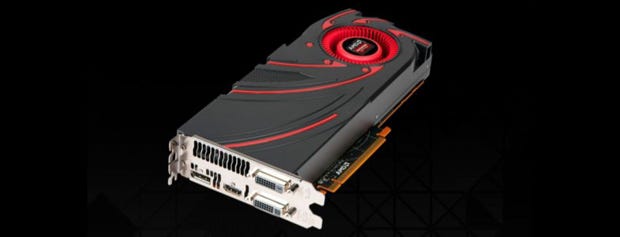Week in Tech: AMD's New 285 GPU, NVMe SSDs And Stuff
Tech Of The Week
Oh, you silly GPUs. Remember the days when by your names should we know ye? No longer. Increasingly, both AMD and Nvidia appear to be engaged in a game of one-upmanship when it comes to baffling branding. Enter, therefore, the new AMD Radeon R9 285. The nomenclature suggests it should sit above the existing R9 280, but in fact it's cheaper, less complex and most likely a bit slower. Why not Radeon R9 275? I have no idea. Still, it looks like a promising new option in terms of bang for your buck. Meanwhile, the complete package for next-gen SSD performance is finally coming together as a major new controller chipset with support for NVMe is announced. Yes, NVMe! Oh and on a related note, it now looks like you might want to skip Intel's upcoming Broadwell architecture / CPU family / platform / whatever and jump straight to Skylake. Details after the break.
AMD's new graphics card
The new AMD Radeon R9 285 graphics chipset, then. For the record, the new 285 is more important for AMD than it is for you and we. Going by the information released so far, which is admittedly a bit patchy, it's not a revolutionary new GPU or chip architecture.
Instead, it's about delivering a similar sort of gaming experience as the existing Radeon R9 280 for a bit less money in terms of retail pricing and – here's the critical point – presumably at a significantly lower production cost.
The problem for AMD (and Nvidia of late) has been production partner TSMC's inability to keep the Moore's Law die shrink thing on schedule. TSMC has been stuck on 28nm for an absolute age.
As a consequence, a little while back AMD found itself launching a new high-end GPU (the Radeon R9 290 series) on the same 28nm process as its incumbent high-end GPU (the Radeon HD 7900 series, which was subsequently rebadged the R9 280).
They're both big, expensive chips and the new 285 is a stopgap solution to that problem of making loads of really big, expensive chips while everyone waits for TSMC to get a grip - or AMD shifts production to Global Foundaries, which of course was once part of AMD. Aaaaaaaaanyway, what AMD has essentially done is to take a look at the 280 and identified which bits of the chip it can hack out without dramatically borking gaming performance. The result is a leaner, more cost efficient chip.
Not every detail of the specification has been released, but here's what we do know. It packs the same stream shader count as the R9 280, thus 1,792 of the tiny number-crunching blighters. As for texture units and ROPs (don't ask, if you don't know, you probably won't care), we're talking 112 and 32, once again making the 285 a dead ringer for the 280.
Where's the difference, then? It's the memory subsystem. The 285 recieves a cut-down 256-bit bus to the 280's hefty 384-bit item. So much less bandwidth even taking into account the slightly higher 5.5GHz effective data rate of the graphics memory, up from 5GHz.
Oh, and the standard memory buffer shrinks from 3GB to 2GB, though this last delta is something board makers are free to close up should they choose. The clocks which are very marginally down from 933MHz to 918MHz for the boost clock, too. AMD hasn't revealed the default clock.
Price wise, the official number is $249 for the new 285 with ye olde 280 rocking in at $279 ye olde 280X rocking in at $299. UK Radeon R9 280s kick off around £160 and 280X's around £195, so call that £150 or thereabouts for the new 285 on this side of the Pond.
What kind of value does that represent? As yet, it's not entirely clear. It's possible the new 285 packs an exciting new revision of AMD's GCN architecture that does funky things in terms of performance à la Nvidia's Maxwell architecture. Could this be GCN 1.2?
If it is, AMD is keeping bloody quiet about it. Moreover, if it was something dramatically new and faster, its sub-R9 280 pricing would be pretty odd. So I'm thinking this is so-called GCN 1.1 and the pricing reflects its performance.
Personally, I'd spend that bit more and get the 280 with its wider bus. It'll likely hold up better over time at higher resolutions. It's a proper high-end chip and that tends to make for superior longevity.
One last thing - the 285 goes on sale 2nd September. Next!
Faster SSDs
In other news, Marvell has announced its NVMe-Enabled, PCI-E 3.0 x4 88SS1093 SSD controller. Cue much rejoicing. To decode that specgasm, it's a controller designed for the new PCI Express-based drive interfaces (M.2 and SATA Express, discussed in posts passim), it supports up to four PCI -E gen three lanes and thus up to 4GB/s of bandwidth (real-world bandwidth will be a bit less) and it does the new fangled NVMe thing.
The latter bit means it doesn't suffer from the overheads and latencies of the AHCI storage control protocol, which is the standard protocol for SATA drives and was never concieved with solid-state storage in mind. NVMe was designed for SSDs and should be much faster for random access performance, I reckon.
Anyway, Marvell controllers are found in some of the best value drives, including Crucial's SSDs, so the prospect of an NVMe Marvell controller rolling out to affordable but fast SSDs sounds good to me.
However, the whole PCI-E thing raises issues. To get proper performance, you need to use the PCI-E lanes on the CPU die itself, not any hobbled PCI-E lanes that might be hung off the chipset and share bandwidth with all and sundry.
Now, Intel's mainstream LGA1150 CPUs only sport 16 lanes on the CPU die, so any lanes used for storage can't be used for graphics. Arguably, eight lanes of gen three PCI-E is enough for a single GPU. But in an ideal world, you'd have the full 16.
Well, rumour has it that Intel's upcoming Skylake generation of mainstream CPUs will sport 20 lanes on-die. And thus you can have your 16-lane GPU cake and eat your four-lane NVMe- enabled SSD. Of course, the slight snag is that we've still to see any CPUs from Intel's next-gen Broadwell family actually on sale as yet. Skylake actually comes after Broadwell and so is fully two generations away.
However, despite the delay rolling out Broadwell, it looks like Skylake might stick to the original schedule, in which case we should see it on the desktop next year. Whatever, it's something to factor into your upgrade plans.
If your PC is really chugging along with a magnetic drive, an old SSD, a crap CPU or whatever, ignore all of the above and dive into a Haswell system today using Intel's existing processors and platforms. But if it's humming along OK and you're are flirting with the idea of an indulgent upgrade, perhaps wait until it's clear just when Skylake is coming and what it will offer.










